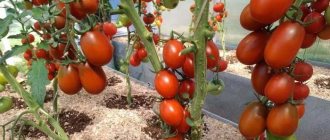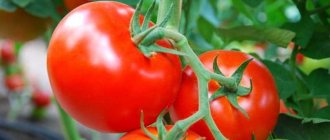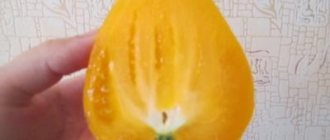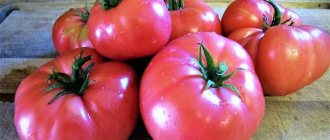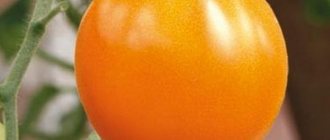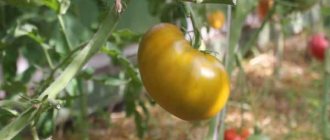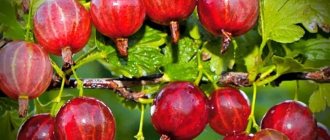Tomato De Barao Golden: variety description
| Variety name | De Barao Golden |
| general description | Mid-season indeterminate variety |
| Originator | Brazil |
| Ripening period | 110-120 days |
| Form | Elongated, with a small nose |
| Color | Yellow |
| Average weight of tomatoes | 80-90 grams |
| Application | Universal |
| Productivity of the variety | 8-12 kg per bush |
| Features of cultivation | Standard agricultural technology |
| Disease resistance | Resistant to late blight |
In our country, this tomato has been widely grown since the 90s; the variety itself was bred in Brazil.
It has taken root well in Russia due to its taste and high yield. “De Barao Gold” is indeterminate and does not form a standard. Ripening time is average. From the moment of planting to the harvest of the first harvest, 110-120 days pass. New branches grow as the plant grows, providing a constant and long-lasting harvest until hard frost.
This is a truly gigantic plant that, with good care, grows up to 2 meters in height and requires strong, powerful support. It grows well and quickly both in open ground and in greenhouses.
The only important condition is that it requires a lot of space, both in width and height; in a small area this giant will grow poorly and its yield will drop.
Growing
After planting, tomatoes require routine care, including:
- watering;
- weeding and loosening;
- garter;
- feeding;
- stepsoning.
Watering
It is better to water early in the morning. In the morning, condensation will not form and it will not settle on the plant, which means there will be no threat of infection with fungal diseases.
You need to water with warm, settled water. To do this, gardeners fill large containers (barrels) with water, and during a warm day the water heats up. Cold water will stress the plant and slow down its growth.
You need to water the tomatoes at the root, making sure that moisture does not get on the leaves, flowers or the tomatoes themselves.
Tomato does not like too frequent watering. He likes it best when he is watered generously, but not often. This can be 1-2 times a week, not more often. In particularly cloudy weather - no more than once every 10 days.
Weeding and loosening
It's better to combine them. Shallow loosening will not touch the roots, will break the earthen crust, and after it it is very good to pull out the weeds with your hands. It is better to carry out loosening after watering, closer to noon, at which time the picked weeds will quickly fade.
Garter
For the De Barao variety, a garter is simply necessary, because powerful bushes can reach a height of 4 meters. It is better to do the garter like this - stick not too large sticks next to the plant, to which you need to tie the not too tall seedlings. After the seedlings outgrow the height of the sticks, ropes or twine are tied to the sticks (but not too thin so that they cannot cut the stem), and after tying the tomato stem to the rope, secure it to the top of the greenhouse.
For open ground, tall pegs will be required. Can be used:
- tall wooden stakes, more than 2 meters high, string a wire between the stakes; 200-300 bushes can be placed on a trellis;
- you can use metal rods and fittings;
- designs made from slats are also suitable;
- I have experience using thick reeds.
If the seedlings are not tied up at a young age, the stems may simply break off under the weight of the branches. And adult tomatoes will not be able to do so without a garter - they will lie on the ground.
Top dressing
Tomatoes need to be fed at least 2 times per season:
- first time - organic,
- the second time - with mineral fertilizers.
Important! The variety is very hardy, however, regular plant care will increase the yield significantly.
Stepsoning
Pinching is the breaking off of excess shoots that grow in the axils of the leaves.
Tomato De Barao can be grown in 1 or 2 trunks. This is a powerful bush, but it will not feed more than 2 trunks. However, if pinching is not carried out, a lot of sprouts can grow. All of them will take nutrients from the plant, shade each other, reduce the yield and delay ripening. Therefore, we remove the excess sprouts that grow in the sinuses every time (after 3-5 days) mercilessly and carefully.
Many gardeners remove not only the stepsons, but also the lower leaves - as soon as the first ovary has formed, all the leaves up to it are cut off. The plant no longer needs them; they only create shadow and excess dampness.
Characteristics
Tomato "De Barao Golden" has many advantages:
- high yield;
- beautiful bright appearance of the fruit;
- the fruits are well stored;
- has good ripening ability;
- the plant is frost-resistant and shade-loving;
- long-term abundant fruiting;
- endurance and excellent immunity;
- widespread use of the finished crop.
Disadvantages of this type:
- proximity to other tomatoes is undesirable;
- due to high growth, it requires a lot of space;
- mandatory powerful support and ties;
- requires mandatory competent stepsoning.
The productivity is quite high, this is one of the advantages. From one large plant you can get 8-12 kg. Under good climatic conditions and rich regular feeding, the yield can be increased to 20 kg.
You can compare the yield of this variety with others in the table:
| Variety name | Productivity |
| De Barao Yellow | 8-12 kg per bush |
| Soyuz 8 | 15-19 kg per square meter |
| Balcony miracle | 2 kg per bush |
| Red Dome | 17 kg per square meter |
| Blagovest f1 | 16-17 kg per square meter |
| King of the Early | 12-15 kg per square meter |
| Nikola | 8 kg per square meter |
| Ob domes | 4-6 kg per bush |
| King of Beauty | 5.5-7 kg per bush |
| Pink fleshy | 5-6 kg per square meter |
Fruit characteristics:
- 6-8 brushes are formed on each branch.
- Each of them has about 8-10 fruits.
- The tomatoes grow together, in large, beautiful clusters.
- They are cream shaped and yellow or light orange in color.
- At the tip of the fruit there is a pointed nose, like all De Barao representatives.
- The fruit weight is average, 80-90 grams.
- The pulp is tasty, juicy, sweet and sour.
- Number of chambers 2, few seeds.
- Dry matter content about 5%.
De Barao Golden tomatoes are perfect for canning. Their bright yellow color will decorate any jar of prefabricated pickling. Can be used fresh, in salads and first courses. Good to use dried. These tomatoes produce delicious tomato juice; as a rule, they are not processed into tomato paste.
You can compare the weight of the fruits of this variety with others in the table:
| Variety name | Fruit weight |
| De Barao Yellow | 80-90 grams |
| Morozko | 50-200 grams |
| Octopus f1 | 150 grams |
| Red cheeks | 100g |
| Pink fleshy | 350 grams |
| Red Dome | 150-200 grams |
| Honey cream | 60-70 grams |
| Siberian early ripening | 60-110 grams |
| Domes of Russia | 500 grams |
| Sugar cream | 20-25 grams |
We bring to your attention useful information on the topic: How to grow a lot of tasty tomatoes in open ground? How to get excellent harvests in greenhouses all year round? What subtleties of agricultural technology of early varieties should everyone know?
Tomatoes De Barao - care
After planting the crop in a permanent place, it is not watered for 12 days. After 10 days, they are tied to a strong trellis, 2.5 m high. Water early in the morning, without waterlogging the soil. Pink De Barao tomatoes (and varieties of other colors) are pollinated at a temperature of +25ºС on a sunny day. Lightly shake the brushes with flowers. Immediately after pollination, spray the plant with water from a spray bottle. Be sure to carry out ventilation and loosening of the soil, especially in the flowering phase. Pinch off the tops 45 days before the end of the growing season. Remove the upper cluster that has not blossomed to provide nutrition to the growing fruit.
Feeding De Barao tomatoes
To create favorable conditions for fruiting, plants need regular supplements. During the period of growth and formation of ovaries, it is necessary to make five root and foliar feedings. To do this, prepare compositions based on 10 liters of water. Add the drug in the required dosage and dissolve thoroughly. Types of fertilizing for red De Barao tomatoes:
- 20 days after planting: dilute 1 tbsp in 10 liters of water. spoon of “Effecton” and “Agricola-Vegeta” per 1 liter per bush.
- After 10 days, the second introduction of fertilizers: “Effecton” - 1 tbsp. spoon per 10 liters of water and the preparation “Agricola-3” - 20 g. Mix everything, use 5 l/m².
- Third addition after 10 days: dissolve 2 tbsp in 10 liters of water. spoons “Nitrophoska” and 1 tbsp. spoon of Rossa fertilizer 5 l/m².
- The fourth after 12 days, dilute 1 tbsp. a spoonful of superphosphate, potassium sulfate, 40 g of Agricola-3, 5 l/m².
- Last addition after 2 weeks: mix 2 tbsp in 10 liters of water. spoons of Effekton fertilizer, 5 liters per bush.
- For foliar feeding use: “Bud” during flowering, “Epin” during fruit set, “Agricola-3” at any phase of development.
How to plant De Barao tomatoes?
The plant is distinguished by its powerful, unlimited growth pattern, height and volume of the bush. The most important condition for cultivation is pinching the tomato. The yield of De Barao tomato depends on the removal of excess branches and leaves. Plants form one, or less often two, stems, leaving 7-8 clusters of flowers. The basics of breaking out shoots:
- you can leave only one lower shoot with one flower brush;
- branches that have reached 8 cm are removed;
- The stepsons of the De Barao black tomato are not cut off, but broken off, leaving a stump of 2-3 cm;
- It is better to remove stepchildren in the morning so that the wounds dry out faster.
Features of cultivation
“De Barao Golden” is very unpretentious in cultivation and with good support the bush grows to gigantic sizes, up to 2 meters or more. The plant can be planted under trees, along fences and under pillars; it tolerates shade well. Forms beautiful yellow clusters of fruits that require garter. This tall ornamental plant with bright golden clusters will become a real decoration of your site.
“De Barao Yellow” tolerates frost and drought well, and is not afraid of temperature changes. Therefore, the variety is successfully grown in almost all regions, with the exception of the coldest. In the Rostov and Belgorod regions, the Kuban, the Caucasus and the Crimea, it is better to grow in open ground.
In the Far East and in the regions of Siberia, a good harvest can only be obtained in greenhouses. You also need to take into account that this tomato needs a good trellis support, without it the plant will not grow well.
The variety responds well to fertilizing with mineral fertilizers. During active growth, abundant watering is needed. It produces a friendly ovary and bears fruit for a very long time until severe cold weather.
Read useful articles about fertilizers for tomatoes:
- Organic, phosphorus, complex and ready-made fertilizers for seedlings and the TOP best.
- Yeast, iodine, ammonia, hydrogen peroxide, ash, boric acid.
- What is foliar feeding and when picking, how to carry it out.
How to plant De Barao tomatoes?
To get a harvest faster, plants are sown early. It is better to purchase seeds for seedlings in seed breeding stores. Prepare in advance the components for the soil mixture and the container for sowing. Sowing dates depend on the growing region. For greenhouses – 15.02-10.03. For open ground with shelter – 01.03-20.03I. In open ground – 15.03 -25.03. How to plant De Barao tomatoes step by step:
- Prepare a mixture of equal parts of peat, humus, and soil.
- Stir. Add 1 teaspoon of superphosphate, potassium sulfate, and urea to a bucket of soil.
- You can purchase special soil for tomatoes.
- Heat the soil on a baking sheet in the oven at a temperature of +110..115ºС for 20 minutes.
- Before sowing, soak the seeds in the solution: add one of the selected products to 1 liter of water: 1 teaspoon of ash, 1 ml of Epin, 1 teaspoon of Effekton fertilizer, 2 g of Bud.
- Place the seedlings in a cloth and soak for 24 hours at a temperature of +20ºС.
- Place the wet package with seeds in a plastic bag and put it in the refrigerator (not the freezer) to harden for 1-2 days.
- Pour the soil into the prepared container, level it, and compact it slightly.
- The grooves are 1 cm deep, after 5-6 cm carefully pour with any solution for soaking seeds (ash 1 teaspoon per 1 liter of water, Epin 1 ml per 1 liter of water).
- Place the seeds in the grooves at a distance of 2 cm.
- Cover with soil; no need to water.
- To speed up germination, cover with film.
- After seed germination, the film is removed.
- Maintain the temperature for growth: during the day +16..18ºС, at night +13..15ºС.
- Water at the root so that water does not get on the leaf.
- For the second time, apply root fertilizer in the single-leaf phase with Agricola-Forward fertilizer, 1 teaspoon per 1 liter of water.
- Make the second feeding when there are three true leaves: dilute 1 tbsp in a liter of water. a spoonful of the drug "Effekton".
- Place De Barao tomatoes with 2-3 leaves into a separate 500 g container.
- Before picking, pour 0.5 g of manganese per 10 liters of water onto the soil.
- Water once a week, making sure the soil does not dry out too much.
- After 10-12 days, feed with a solution of nitroammophoska 1 tbsp. spoon per 10 liters of water. Use one cup per two plants.
- The seedlings are transplanted to the main place within 60-70 days.
Tomatoes De Barao - planting scheme
Tomatoes grow well in shaded areas. Indeterminate seedlings are planted in rows of one bush at a time or in a checkerboard pattern, diagonally. Maintain a distance between bushes of 50-60 cm. As the interval between plantings increases, the yield decreases by half. When planted sparsely, the De Barao tomato variety branches and many stepsons are formed. Add 2 tbsp to the soil. spoons of superphosphate, 1 tbsp. a spoonful of potassium sulfate, sand, peat, sawdust. They dig up the soil in the greenhouse and disinfect it with a manganese solution (1 g per 10 liters of water). Prepare a hole 5 cm deep, water and plant the bush.
Diseases and pests
The plant has good immunity to late blight. To prevent fungal diseases and fruit rot, greenhouses must be regularly ventilated and the correct light and temperature conditions must be maintained.
This tomato often has more blossom end rot. This phenomenon can affect the entire plant. It can be caused by a lack of calcium or water in the soil. Spraying with wood ash also helps against this disease. Among the harmful insects it can be affected by melon aphids and thrips, the drug “Zubr” is successfully used against them. Mole crickets and slugs can also cause great damage to these bushes. They are combated by loosening the soil, and also using dry mustard or hot ground pepper diluted in water, a 10-liter spoon, and watering the soil around.
“De Barao Golden” is a real decoration of beds and greenhouses. If you have a lot of space on your plot, then be sure to plant this tomato miracle and in three months you will have a good harvest. Have a great season!
Advantages and disadvantages
Based on the characteristics of tomatoes, the De Barao variety has many advantages and virtually no disadvantages.
The undoubted advantages include the following qualities:
- easily tolerates stress and difficult weather conditions;
- highly resistant to typical tomato diseases, in particular late blight;
- unpretentious to the planting site, bears fruit even in the shade;
- high-yielding;
- long period of fruiting, because fresh tomatoes are harvested until October, and when grown in unheated greenhouses until November;
- extremely tasty tomatoes, universal use;
- transportable, tomatoes are stored for a long time and well.
Video
We bring to your attention a video about yellow tomatoes, including the De Barao Yellow tomato:
| Mid-season | Mid-early | Late ripening |
| Anastasia | Budenovka | Premier |
| Raspberry wine | Mystery of nature | Grapefruit |
| Royal gift | Pink King | De Barao the Giant |
| Malachite Box | Cardinal | De Barao |
| Pink heart | Babushkino | Yusupovsky |
| Cypress | Lev Tolstoy | Altaic |
| Giant raspberry | Danko | Rocket |

